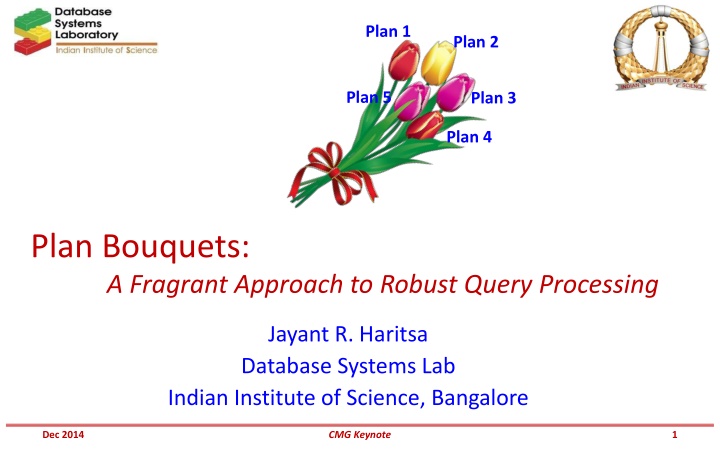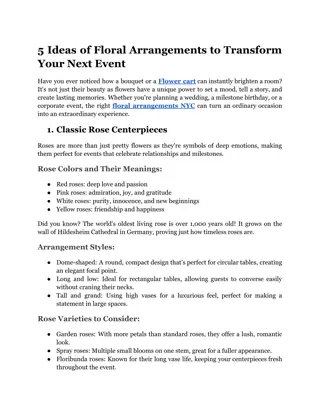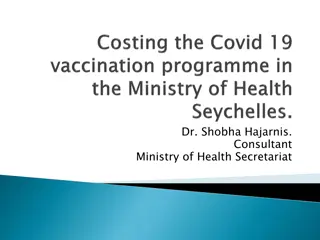
Efficient Query Processing Techniques in Database Systems
Explore the innovative approach of plan bouquets for robust query processing in databases, along with the challenges and solutions in declarative query execution. Dive into cost-based query optimization strategies to enhance SQL query performance significantly by selecting the most efficient execution plan.
Download Presentation

Please find below an Image/Link to download the presentation.
The content on the website is provided AS IS for your information and personal use only. It may not be sold, licensed, or shared on other websites without obtaining consent from the author. If you encounter any issues during the download, it is possible that the publisher has removed the file from their server.
You are allowed to download the files provided on this website for personal or commercial use, subject to the condition that they are used lawfully. All files are the property of their respective owners.
The content on the website is provided AS IS for your information and personal use only. It may not be sold, licensed, or shared on other websites without obtaining consent from the author.
E N D
Presentation Transcript
Plan 1 Plan 2 Plan 5 Plan 3 Plan 4 Plan Bouquets: A Fragrant Approach to Robust Query Processing Jayant R. Haritsa Database Systems Lab Indian Institute of Science, Bangalore Dec 2014 CMG Keynote 1
Talk Theme Declarative query processing with performance guarantees has been a highly desirable but equally elusive goal for the database community over the last three decades. I will present a conceptually new approach, called planbouquets , to address this classical problem. (Joint work with Anshuman Dutt, IISc PhD student) Dec 2014 CMG Keynote 2
Sample Relational Database: Manufacturing Region Supplier PartSupp Nation Orders Customer Part Declarative Lineitem select * from lineitem, orders, part where p_partkey = l_partkey and l_orderkey = o_orderkey and p_retailprice < 1000 SQL query for Complete details of orders for cheap parts Algebraic equivalent: p_retailprice < 1000 (part partkeylineitem orderkey orders) Dec 2014 CMG Keynote 3
Query Execution Plan Ordered (imperative) sequence of steps to process the data (l_orderkey = o_orderkey) (p_partkey = l_partkey) (l_orderkey = o_orderkey) part orders (p_partkey = l_partkey) (p_retailprice < 1000) lineitem lineitem orders part (p_retailprice < 1000) Enormous number of semantically equivalent alternative plans for a query with N relations, there are at least N! join orders multiple algorithmic choices at each node in the plan (e.g. Join operator: Nested Loops, Sort Merge, Hash, Index, ) Dec 2014 CMG Keynote 4
Cost-based Query Optimization Determining the most efficient plan to execute an SQL query Huge performance difference between good and bad plans Only a few good plans Compare all alternative plans with a performance framework consisting of operator cardinality model estimate the quantity of data processing at each operator expected to accurately estimate the number of tuples at each operator summary statistics through histograms operator cost model estimate the time taken to perform the required data processing expected to accurately estimate the time taken to bring a relational page from disk to memory time taken to process filter condition on a given tuple, etc. Dec 2014 CMG Keynote 5
Cardinality Estimation RDBMS (EQ) select * from lineitem, orders, part where p_partkey = l_partkey and l_orderkey = o_orderkey and p_retailprice < 1000 Statistical Metadata Query Optimizer Estimated Join Cardinality 1.2 x 106 Hash Join Estimated Join Cardinality 1.5 x 105 RelScan 1.2 x 106 Hash Join 1.5 x 105 orders 6 x 106 RelScan 4 x 103 RelScan Estimated Selection Cardinality 6 x 106 lineitem 2 x 104 part Base Relation Cardinality Dec 2014 CMG Keynote 6
Canonical Query Optimization Framework Optimal [Min Cost] Plan P(Q) Declarative Query (Q) Query Optimizer Operator Execution Cost Estimation Model Operator Result Cardinality Estimation Model function of (Data Distributions, Data Correlations) e.g. Output Cardinality of Join = ?????? ?????? join filter factor function of (Hardware, DB Engine) e.g. NL Join = |Router| + |Router| x |Rinner| Dec 2014 CMG Keynote 7
Run-time Sub-optimality The supposedly optimal plan-choice from the query optimizer may actually turn out to be highly sub-optimal when the query is executed with this plan. This adverse effect is due to errors in: (a) cost model limited impact, < 30 % (b) cardinality model huge impact, orders of magnitude Coarse statistics, attribute value independence (AVI) assumption, multiplicative error propagation, outdated statistics, query construction, Dec 2014 CMG Keynote 8
Proof by Authority [Guy Lohman, IBM Almaden] Snippet from his recent Sigmod blog post on Is Query Optimization a Solved Problem? Dec 2014 CMG Keynote 9
Selectivity Estimation Error (EQ) (EQ) select * from lineitem, orders, part where p_partkey = l_partkey and l_orderkey = o_orderkey and p_retailprice < 1000 1.2 * 106 Compile time estimate lineitem 6 x 106 Optimizer assumes orders are equally likely for all prices 4 x 103 part 2 x 104 Run time situations All the orders correspond to cheap parts There are no orders for cheap parts 0 6 x 106 lineitem 6 x 106 lineitem 6 x 106 Huge overestimate 4 x 103 4 x 103 Huge underestimate part 2 x 104 part 2 x 104 Dec 2014 10 CMG Keynote
Prior Research (lots!) Sophisticated estimation techniques SIGMOD 1999, VLDB 2001, VLDB 2009, SIGMOD 2010, VLDB 2011, Selection of Robust Plans SIGMOD 1994, PODS 2002, SIGMOD 2005, VLDB 2008, SIGMOD 2010, Runtime Re-optimization techniques SIGMOD 1998, SIGMOD 2000, SIGMOD 2004, SIGMOD 2005, Several novel ideas and formulations, but lacked performance guarantees Dec 2014 CMG Keynote 11
Talk Summary We present plan bouquets , a query processing technique that completely eschews making estimates for error-prone selectivities (normalized cardinalities [0% to 100%]) Plan Bouquet Approach: run-time discovery of selectivities using a compile-time selected bouquet of plans provides worst case performance guarantees wrt omniscient oracle that knows the correct selectivities e.g. for a single error-prone selectivity, relative guarantee of 4 empirical performance well within guaranteed bounds on industrial- strength environments Dec 2014 CMG Keynote 12
Problem Framework Dec 2014 CMG Keynote 13
Selectivity Dimensions 100% Example Query: EQ select * from lineitem, orders, part where p_partkey = l_partkey and l_orderkey = o_orderkey and p_price < 1000 sel (part lineitem) SS Selectivity Space sel ( (part)) 100% 0% sel (lineitem orders) 100% Dec 2014 CMG Keynote 14
Performance Metrics 100% sel (part lineitem) qe estimated selectivity location in SS qa actual run-time location in SS qa(75%, 62%, 85%) Poe optimal plan for qe Poa optimal plan for qa qe(5%, 2%, 8%) 0% 100% sel ( (part)) ????(???,??) ????(???,??) ?????? ??,?? = [?, ) sel (lineitem orders) 100% ????????? ??? = ??? ?????? ??,?? ??,?? ?? ????????? ??? = ??? ?????? ??,?? ??,?? ?? Dec 2014 CMG Keynote 15
Main Assumptions Plan Cost Monotonicity (Mandatory) Perfect Cost Model (relaxed at end of talk) Independent SS Dimensions (ongoing work) PCM: For any plan P and distinct selectivity locations q1 and q2 cost (P, q1) < cost (P, q2) (q1 is dominated by q2 in SS) Cost(P, q2) =100 q2 if q1 q2 cost(P, qi) < 100 Dec 2014 CMG Keynote 16
Current Optimizer Behavior on One-dimensional SS Dec 2014 CMG Keynote 17
Parametric Optimal Set of Plans (POSP) ( Parametric version of EQ) select * from lineitem, orders, part where p_partkey = l_partkey and l_orderkey = o_orderkey and SEL (PART) = $1 log-scale P5 P4 P3 P2 Using Selectivity Injection P1 L: Lineitem O: Orders P: Part NL: Nested Loop Join MJ: Merge Join HJ: Hash Join log-scale Dec 2014 CMG Keynote 18
POSP Performance Profile (across SS) P5 P4 P3 P2 P1 Dec 2014 CMG Keynote 19
Sub-optimality Profile (across SS) P1 SubOpt (1%, 99%) = 20 P5 P5 SubOpt (80%, 0.01%) = 100 P4 P3 P2 MaxSubOpt = 100 AvgSubOpt = 1.8 P1 Dec 2014 CMG Keynote 20
Bouquet Approach in 1D SS Dec 2014 CMG Keynote 21
Bouquet Identification Step 1: Draw cost steps with cost-ratio r=2 (geometric progression). Step 2: Find plans at intersection of optimal profile with cost steps IC7 P5 IC6 P3 IC5 P2 IC4 P1 IC3 P1 IC2 P1 IC1 P1 Bouquet = {P1, P2, P3, P5} Dec 2014 CMG Keynote 22
Bouquet Execution Let qa = 5% (1) Execute P1 with budget IC1(1.2E4) (2) Throw away results of P1 Execute P1 with budget IC2(2.4E4) (3) Throw away results of P1 Execute P1 with budget IC3(4.8E4) (4) Throw away results of P1 Execute P1 with budget IC2(9.6E4) (5) Throw away results of P1 Execute P2 with budget IC5(1.9E5) (6) Throw away results of P2 Execute P3 with budget IC6(3.8E5) P3 completes with cost 3.4E5 IC7 P5 IC6 P3 IC5 P2 IC4 IC3 IC2 IC1 P1 qa = 5% Dec 2014 CMG Keynote 23
Stupid Idea ? Yes! Very stupid! We are expending lots and lots of wasted effort at both planning time (producing PIC) and at execution time (throwing away work) ! Certainly a recipe for disaster But, with careful engineering, can actually be made to work surprisingly well rest of talk Dec 2014 CMG Keynote 24
Bouquet Execution Let qa = 5% (1) Execute P1 with budget IC1(1.2E4) (2) Throw away results of P1 Execute P1 with budget IC2(2.4E4) (3) Throw away results of P1 Execute P1 with budget IC3(4.8E4) (4) Throw away results of P1 Execute P1 with budget IC2(9.6E4) (5) Throw away results of P1 Execute P2 with budget IC5(1.9E5) (6) Throw away results of P2 Execute P3 with budget IC6(3.8E5) P3 completes with cost 3.4E5 Bouquet Cost = 3.4 E5 (P3) + 1.92 E5 (P2) + 0.96 E5 (P1) + 0.48 E5 (P1) + 0.24 E5 (P1) + IC7 0.12 E5 (P1) = 7.1 E5 P5 IC6 P3 IC5 SubOpt (*, 5%) = 7.1/3.4 = 2.1 P2 IC4 IC3 With obvious optimization SubOpt(*, 5%) = 6.3/3.4 = 1.8 IC2 IC1 P1 qa = 5% Dec 2014 CMG Keynote 25
Bouquet Performance (EQ) Native Optimizer MaxSubOpt = 100 AvgSubOpt = 1.8 Bouquet (Enhanced) MaxSubOpt = 3.1 AvgSubOpt = 1.7 Dec 2014 CMG Keynote 26
Worst Case Cost Analysis Bouquet (upper bound) Optimal (lower bound) Pk would complete within its budget when qa (qk-1, qk] Dec 2014 CMG Keynote 27
1D Performance Bound ?????????? ?,?? = ???? ??? + ???? ??? + + ???? ??? ? + ????(???) = ? + ?? ?(?? ?) (? ?) + + ??? ? + ??? ? = (Implication of PCM) ?????????? ?,?? ??? ? Reaches minima at r = 2 MSO = 4 Best performance achievable by any deterministic online algorithm! Dec 2014 CMG Keynote 28
Bouquet Architecture Dec 2014 CMG Keynote 29
Connection to Online Bidding Problem There is an object D with hidden value V in range (1, 100) Your task is to bid for D until you acquire it under the following rules: If the bid B < V, then you forfeit B, and bid again If the bid B V, then you pay B and acquire D Your goal is to minimize the worst-case ratio of your total payment to the object value, i.e. min ( (B1 + B2+ + Bk) / V) Bid doubling algorithm is best possible choice Dec 2014 CMG Keynote 30
Bouquet Approach in 2D SS Dec 2014 CMG Keynote 31
2D Bouquet Identification Cost (normalized) Isocost Contours Isocost Planes Cost Plans Plans Multiple Plans per contour sel-X sel-Y CMG Keynote Dec 2014 32
Characteristics of 2D Contours s e l - Y s e l - Y sel - X sel - X 2D contours Hyperbolic curves Multiple plans per contour Third quadrant coverage (due to PCM) P2k can complete any query with actual selectivities(qa) in the shaded region within cost(ICk) Dec 2014 CMG Keynote 33
Crossing 2D Contours Covered by only one plan in contour s e l - Y Covered by all plans in contour sel - X Entire set of contour plans must be executed to fully cover all locations under ICk Dec 2014 CMG Keynote 34
2D Performance Analysis When qa (ICk-1, ICk] Number of plans on ith contour ? ?????????? = [?? ???? ???] ?=? = max(ni) ? ?????????? ? ???? ??? ?=? (Using 1D Analysis) ??????????????? = ?? Bound for N-dimensions: ??????????????? = ? ????????? Dec 2014 CMG Keynote 35
Dealing with large In practice, can often be large, even in 100s, making the performance guarantee of 4 impractically weak Reducing Compile Time: Anorexic POSP reduction [VLDB 2007] Run Time: Explicit Monitoring of Selectivity Lower Bounds Spilling-based Execution Dec 2014 CMG Keynote 36
1) Reducing with Anorexic Reduction Collapse a large set of POSP plans on a selectivity space into a reduced cover that provides performance within a (1+ ) factor of the optimal at all locations in the ESS. With = 0.2, invariably obtain a small-sized (< 10) cover. Reduced to 5 plans 76 plans Dec 2014 CMG Keynote 37
MSO guarantees (compile time) Query (dim) POSP MSO Bound (POSP) = 4 POSP reduced ( =0.2) MSO Bound (reduced) = 4 reduced(1+ ) Q5 (3D) 11 44 3 14.4 Q7 (3D) 13 52 3 14.4 TPC-H Q8 (4D) 88 352 7 33.6 Q7 (5D) 111 444 9 43.2 Q15 (3D) 7 28 3 14.4 Q96 (3D) 6 24 3 14.4 Q7 (4D) 29 116 4 19.2 TPC-DS Q19 (5D) 159 636 8 38.4 Q26 (4D) 25 100 5 24.0 Q91 (4D) 94 376 9 43.2 Dec 2014 CMG Keynote 38
2) Reducing with Selectivity Monitoring When (cost-limited) execution of plans on ICk does not complete the query, we know that qa does not lie under ICk but qa could lie anywhere beyond ICk s e l - Y By monitoring lower bounds on selectivities during execution(qrun) qa can only be in first quadrant of qrun (# of tuples at a node can only be greater than what has already been seen) (Pi, Pi+5 need not be executed) lesser effective value of sel - X Dec 2014 CMG Keynote 39
3) Maximizing selectivity movement The selectivity movement at a node N in the plan tree is increased by spilling (dropping without forwarding) the output of N, thereby focusing the entire execution budget on the sub-tree rooted at N. Spill modification to a plan To enhance movement of join selectivity SL, the join output tuples are spilled, instead of being forwarded to the upstream nodes. Dec 2014 CMG Keynote 40
Empirical Evaluation Dec 2014 CMG Keynote 41
Experimental Testbed Database Systems: PostgreSQL and COM (commercial engine) Databases: TPC-H and TPC-DS Physical Schema: Indexes on all attributes present in query predicates Workload: 10 complex queries from TPC-H and TPC-DS with SS having upto 5 error dimensions Metrics: Computed MSO and ASO using Abstract Plan Costing over SS Dec 2014 CMG Keynote 42
Performance on PostgreSQL Native Optimizer Log-scale Bouquet MSO bounds For many DS queries MSO improves from 106to 10 ASO improves from 102 to 5 ASO not compromised to reduce MSO! Dec 2014 CMG Keynote 43
Performance with COM Robustness improvements not artifact of a specific engine Dec 2014 CMG Keynote 44
Sample Savings in Wall-clock Time Performance Summary NAT Enhanced Bouquet Optimal (PostgreSQL) 600 sec 69 sec 16.1 sec Contour ID Avg. Execution Time (in sec) # Executions (Enhanced Bouquet) Time (in sec) (Enhanced Bouquet) 1 0.6 2 1.2 2 3.1 2 6.2 In spite of uncalibrated cost model 3 4.8 3 14.4 4 6.2 3 18.6 5 12.2 1 12.2 6 16.1 1 16.1 Total 12 68.7 Query based on TPC-H Q8 Dec 2014 CMG Keynote 45
Summary Plan bouquet approach achieves bounded performance sub-optimality using a (cost-limited) plan execution sequence guided by isocost contours defined over the optimal performance curve robust to changes in data distribution only qa changes bouquet remains same easy to deploy bouquet layer on top of the database engine repeatability in execution strategy (important for industry) qe is always zero, depends only on qa independent of metadata contents Important distinction from re-optimization techniques Dec 2014 CMG Keynote 46
Limitations Bouquet identification overheads are exponential in the ESS dimensionality unsuitable for on-the-fly queries Not suitable for latency sensitive applications need to wait for final execution to complete Not suitable for update queries each partial execution needs to be garbage-cleaned on termination Not suitable for hinted queries multiple plans used Database scaling requires bouquet re-computation but robust to changes in data distribution Dec 2014 CMG Keynote 47
Incorporating Cost Model Error If cost model error is bounded by ? , that is ????????????? ?????????? ? ?+?,? + ? then ?????????? ?????????? ? + ?? for = 0.4 MSObounded 2 MSOperfect Dec 2014 CMG Keynote 48
For more details, visit project website: dsl.serc.iisc.ernet.in/projects/QUEST Concepts paper: ACM Sigmod 2014 Demo paper: VLDB 2014 Dec 2014 CMG Keynote 49
Take Away Plan 1 Near Plan 2 Optimal Query Execution Performance Plan 3 SQL Query Plan 5 Plan 4 Do you know the correct selectivities ? Dec 2014 CMG Keynote 50






















